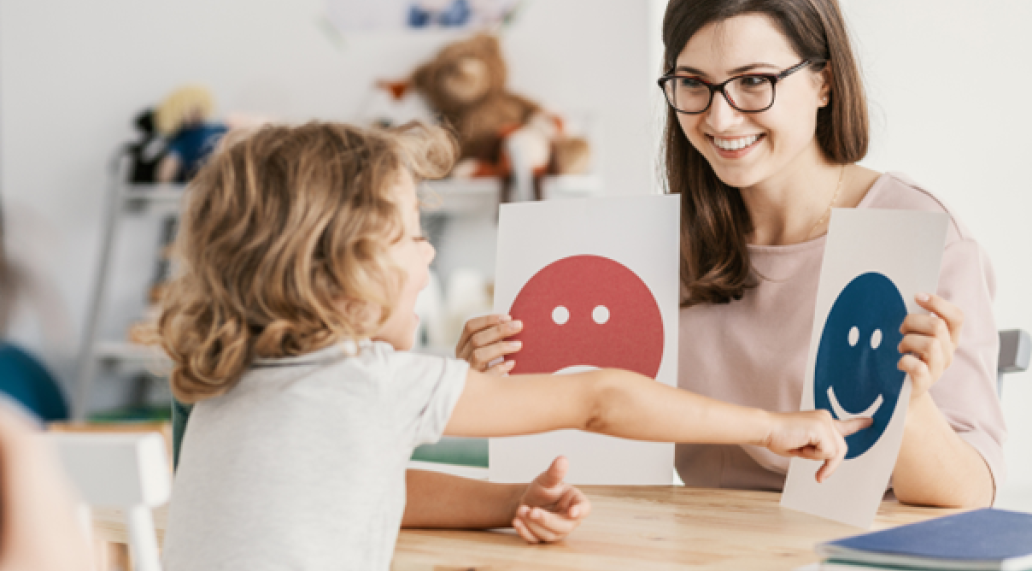
How do feelings develop?
During the process of emotional development, children first learn to perceive emotions, then to express them (facial expressions and gestures), to deal with them or regulate them, and finally to react to the emotions of others. Particularly young children initially cannot regulate emotions such as anger or sadness themselves, nor can they recognize them in others. Emotions also do not develop simultaneously, but rather gradually. At the beginning, children mostly feel joy, and later emotions of anger, frustration, or sadness are added. Compassion and empathy also develop later. It takes several years for a child to empathize with others and understand what emotions other people have or what emotions they evoke in others.
Think before you act
The ability to control an impulse, such as a feeling or an affect — the so-called "impulse control" — develops naturally over the course of childhood. Research shows that complete development is not reached until around the age of 25. A particularly strong development occurs between the ages of three and seven. During this time, the expression of emotions, emotional knowledge, and emotional regulation develop in parallel and influence each other. In general, it can be assumed: the younger the child, the more impulsive their behavior; the older, the more reasonable and considered their reactions in various situations. It is therefore completely normal that strong emotions like anger or sadness cannot yet be controlled in early childhood and may seem disproportionately intense to parents. Parents should always be aware of this when a child, for example, has a strong tantrum or bursts into tears because they can't have ice cream or are simply tired.
Impulse control is important for children to align their needs with those of the outside world. This helps them express and focus better in school, for example, and develop greater receptivity. Children with well-developed impulse control often make friends more quickly and feel comfortable in a community sooner.
Practical Tips for Parents
Parents play an important role in a child's emotional development. In the first two years of life, the child already learns to recognize the emotions of caregivers — for example, the cheerful voice of the mother — and to respond to them, such as by smiling. Therefore, parents should be able to provide an environment in which children can develop their own impulse control well. A good foundation for this is a consistent and loving relationship with the child and a needs-based and attachment-oriented parenting approach.
Further practical tips on how parents can support their child's emotional development can be found here:
Naming and Recognizing Feelings: If you notice an expression of emotion in your child, do not ignore it and try to name the feeling as clearly and neutrally as possible: "You're crying right now. I see that you're sad." Negative feelings, in particular, can cause discomfort in adults and tend to be suppressed, but every feeling is important and should be allowed, including sadness or anger. For children to understand how to correctly identify an emotion, they must first learn what it actually is. Especially young children can struggle to express their emotions due to their development. Therefore, it's important for parents to name the feeling, for example: "I see you're sad." If the child is older, additional questions can also be asked, such as: "How do you feel right now?" This gives the child the opportunity to practice identifying feelings correctly.
Openly Dealing with Emotions: There are no "wrong" feelings, so you should not try to talk your child out of something or ignore their feelings. Be present and listen, don't cut off the conversation and let your child finish speaking if they need to talk. This provides feedback that it is okay and important to express and talk about feelings. Also, avoid using "clever sayings" like "It's not that bad" during the conversation. Sometimes it is enough just to be there for your child, to give them a hug and closeness, to signal that they are not alone with their feelings.
Stay calm: Show understanding for your child's situation and be patient. Keep in mind that emotions are complex and can be overwhelming. It takes time to understand and control them. Stay calm and composed as much as you can, especially during tantrums or crying outbursts. This creates an atmosphere where the child can calm down and the situation doesn't become more tense.
Recognize needs and try out regulation strategies: Find out together what might be behind an emotional outburst and what a suitable way to deal with it is.öwants the child when it is sad or angry is? Perhaps it is really sad because it didn't get a toy or another child pushed it in kindergarten. However, it might also have a certain need that it cannot yet name or show, such as exhaustion, hunger, or the urge to move. With strong emotions like anger, you can try to calm your child using various approaches, such as taking deep breaths together several times or going outside for fresh air. In general, regular exercise can be beneficial for managing emotions, as it reduces stress hormones and provides an outlet for various emotions.
Learn to Handle Emotions Playfully: A good way, especially for younger children, is to playfully name feelings, for example through emoticons.hlskarten, picture books, or a mood clock. For this, a circle made of cardboard is divided into four sections. Four different feelings are recorded in these sections, for example, "happy," "sad," "angry," or "afraid." A movable pointer is attached in the middle. Children cöcan now show what mood they are in.
Show your own feelings: Even parents don't have to be perfect. They are allowed to show emotions and make mistakes, so don't hide your feelings from your children. Parents often feel that they must always appear strong and composed to their children, but in the worst case, this conveys exactly the wrong image, namely that they themselves are not allowed to show their emotions. Keep reminding yourself that emotions are human and we need them as a kind of "rudder" in life.
Model self-control: Children learn from adults in their environment how to behave in different life situations. Reference persons who regulate themselves well köPeople who respond calmly, patiently, and sensibly are good role models for their own children. They create an atmosphere in which the child can learn impulse control and become...öresembled a natural development of this ability. In return, stressed, impatient, impulsively acting adults make it difficult for the child to develop a different behavior.
Each child expresses feelings differently, and it's important to consider each situation individually. Would you like more practical tips? Then feel free to contact us for personal advice. The famPLUS team supports you with educational questions, can address your family situation individually, and provide you with age-appropriate tips.
by Esther Marake
Anger, Frustration, and Tears: The famPLUS Webinar
Would you like to delve deeper into the topic? famPLUS will soon be offering a webinar on "Anger, Frustration, and Tears — Practical Tips for Dealing with Emotions in Children and Adolescents." Feel free to discuss your interest in participating in our webinar with your employer.
Sources:
This is how children learn to handle emotions well. Life and Parenting online. Retrieved on 20.07.2023
5 Tips for Impulse Control in Children. Tina Pichler Blog. Retrieved on 07/20/2023
Emotional development from the beginning – How do children learn to handle emotions competently? (Part 1)Dr. Monika Wertfein on familyhandbook.de Retrieved on 07/20/2023
Emotional Development in Children – Understanding, Supporting, PromotingOnline at StarkeKids.com. Retrieved on 07/20/2023


